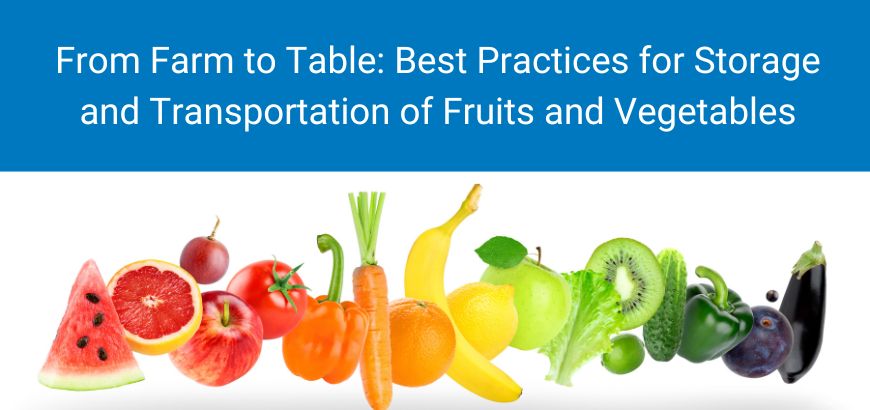From Farm to Table: Best Practices for Storage and Transportation of Fruits and Vegetables

Admin
March 6, 2023


March 6, 2023

It is crucial for both farmers and businesses to reduce post-harvest losses throughout the food supply chain. With consumers becoming more aware and conscious about their food choices and farm-to-table concept, handling and distribution of perishables are a must.
This all comes down to following the best practices for the storage and transportation of fruits and vegetables. Here’s what you all need to know!
Fruits and vegetables continue with the process of respiration and other biological processes even after harvesting. These factors can influence post-harvest quality and losses. Additionally, the ripening rate (ethylene production) has to be taken into account.
Since fruits, vegetables, and root crops contain 65 to 95 per cent water, post-harvest life depends on the rate at which water losses occur and the stored food reserves used. Hence, when the food and water reserve in the produce gets exhausted, the produce starts to decay and dies.
Overall, it is the interaction of various metabolic and environmental factors that lead to deterioration and the main causes include water loss, diseases and pests, chilling injuries, physical injuries, etc.
Hence, the use of the right post-harvest technology can help minimize losses and maintain quality as high as possible.

Temperature control plays a key role in extending the shelf-life of fresh commodities or produce after harvest. Usually, temperature management starts by rapidly removing field heat using either of the following cooling methods.
Post that, the commodities are stored in cold storage facilities.
Cold storage solutions should be well constructed and equipped with the features discussed below.
Rinac’s cold room storage solutions have been used for decades across various industries for their flexibility, scalability, energy-savings, modular designs, and robust construction. Explore our cold storage solutions here!
Humidity levels control the water losses, decay, occurrence of physiological disorders, and ripening. Ideally, the relative humidity levels should be between 85 and 95 per cent for the majority of fruits, 95 to 98 per cent for vegetables (pumpkins and onions at 70—75 per cent), and about 95 to 100 per cent for root vegetables.
Relative humidity can be controlled by the following methods.
Here’s a look at the ideal storage conditions required for common fruit and vegetable.
| COMMODITY | TEMPERATURE (F0) | RELATIVE HUMIDITY (%) | APPROXIMATE STORAGE LIFE |
FRUITS
| Apples | 30-40 | 90-95 | 1-12 months |
| Apricots | 31-32 | 90-95 | 1-week |
BERRIES
| Blackberries | 31-32 | 90-95 | 2-3 days |
| Black currants | 31-32 | 90-95 | 1-4 weeks |
| Gooseberries | 31-32 | 90-95 | 1-2 weeks |
| Raspberries | 31-32 | 90-95 | 2-3 days |
| Strawberries | 32 | 90-95 | 3 -7 days |
| Cherry(sour) | 32 | 90-95 | 3 -7 days |
| Cherry(sweet) | 30-31 | 90-95 | 2-3 weeks |
| Peaches | 31-32 | 90-95 | 2-4 weeks |
| Pears | 29-31 | 90-95 | 2-7 months |
VEGETABLE
| Onions, green | 32 | 95-100 | 3-4 weeks |
| Onion dry | 32 | 65-70 | 1-8 months |
| Potatoes, early crop | 40 | 90-95 | 4-5 months |
| Potatoes late crop | 38-40 | 90-95 | 5-10 months |
| Carrot mature | 32 | 98-100 | 7-9 months |
| Cauliflower | 32 | 95-98 | 3-4 weeks |
| Cucumber | 50-55 | 95 | 10-14 days |
| Pumpkins | 50-55 | 50-70 | 2-3 months |
| Class
|
Respiration
Rate (Btu\ton\24 hrs) |
Commodity |
| Very low | <5 | Nut, dates, dried fruits and vegetables |
| Low | 5-10 | Apples, grape, garlic, onion, potato(mature), sweet potatoes |
| Moderate | 10-20 | Apricot, cherry, peach, pear, plum, cabbage, carrot, tomato and potato (immature) |
| High | 20-40 | Strawberry, blackberry, lima bean, raspberry, cauliflower |
| Very high | 40-60 | Snap bean, green onion, brussels, sprouts |
Transporting fresh produce presents many challenges due to temperature sensitivities and perishability and, thus, requires complete adherence to all sanitary regulations. Fresh produce is used for fruits and vegetables that have not undergone any processing. When the word “fresh” appears on a product’s label or in another labelling that suggests or implies that the item is unprocessed, it refers to the food’s natural condition without any freezing, thermal processing, or other preservation methods.
Challenges in Transporting Fresh Produce
Transportation is the critical and most costly part of the marketing channel of fresh commodities. It involves multiple steps from the point of origin to the point of use and depends on the distance, perishability, and value of the produce.
The most damage and losses during non-refrigerated transportation are caused due to overheating (inadequate temperature control) and mechanical damage (crushing of packages in the container). Every year, a huge quantity of fresh produce is lost during transportation, causing losses. Also, fruit or vegetables that have passed their prime state may lose flavour and nutrients or even cause health problems.
These challenges need to be controlled by taking the appropriate actions.
Here’s a look at fruits and vegetables classified by susceptibility to injury by temperatures below 320 F.
| Group 1
Most susceptible |
Group 2
Moderately susceptible |
Group 3
Least susceptible |
| Apricots | Apples | Beets |
| Asparagus
|
Broccoli, sprouting | Brussels Sprouts |
| Beans, snap
|
Cabbage, new | Cabbage, mature and savoy |
| Berries (except cranberries) | Carrots | Kale |
| Cucumbers | Cauliflower | Kohlrabi |
| Okra | Grapes | Turnip |
Here are some options businesses use when transporting fresh fruits and vegetables.
Rinac’s ChillKart, eutectic refrigerated trucks require NO FUEL or ENERGY to refrigerate and instead maintain cold temperatures during transportation with eutectic plates placed inside the insulated truck body. ChillKart reduces your annual expense significantly by almost 50% when compared to reefer trucks!
Farm-to-table concept is gaining popularity and that is why adopting the best-in-class post-harvest technologies have become a must. To maintain the nutritional value, quality, and freshness of the commodities including fruits and vegetables, it is high time you follow the best storage and transportation practices and invest in the right cold chain solutions.
To know more about how you can maximize your profits, get in touch with us today!